- Timings in GMT/UTC
- Red title is a fatal accident
This data represents some well known cases.
1956
25 December; Douglas DC-3 (Dakota) ; AP-ACZ : after arriving in Gilgit at 0514, the captain elected not to carry any passengers on the return flight to Rawalpindi due weather conditions. The DC-3 took off at 0900 and climbed to an altitude of 10,000 feet encountering rain, sleet and thunderstorm as the aircraft entered a gorge flanked by mountains rising up to 17000 feet. Two circuits were flown near the village of Jalkot. The aircraft struck a peak ( Lastgarush Galli) at 14-15000 ft. Radio transmissions of the flight in the Indus Valley were picked up by a Royal Pakistan Air Force aircraft at 0956 near Rawalpindi. Wreckage was found on 11 March 1956. The probable cause: the captain was attempting a flight beyond his ability or experience There were 3 persons on board and there were no survivors.
25 December; Convair 240; AP-AHO : Approaching Bombay’s Santa Cruz Runway 27, the Convair had a mid-air collision with a Stinson aircraft (VT-CAR), which had just taken off from Bombay’s Juhu Airport. The Stinson crashed, killing both occupants, while the Convair landed safely. The Convair’s rudder was damaged in the collision. Sector: Karachi-Bombay; 40 on board, no fatalities
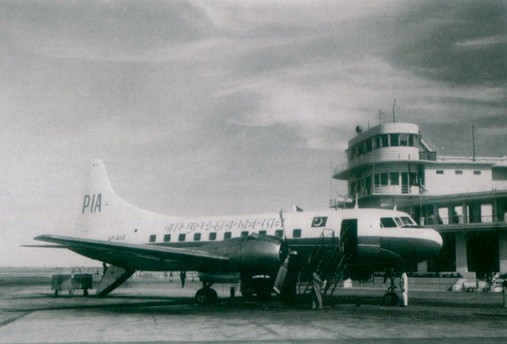
Convair 240 at Karachi Airport
1957
1 July; Douglas DC 3 (Dakota); AP-AJS : the DC-3 departed Chittagong Airport at 0305 for an hour long flight to Dacca. Last communication with the aircraft was at 0317 before it crashed on tidal flats in the Bay of Bengal. The wreckage was found on 4 July, on the coast of Charlakhi Island about 14 miles south-east of Noakhali and 50 miles west of Chittagong. Probable cause: the aircraft broke up structurally in a storm due to excessive load placed on the airframe. Total: 24 on board/24 fatalities
1958
15 May; Convair 240; AP-AEH: the aircraft hit the ground outside the airport area after a night take off from New Delhi’s Palam Airport. The probable cause: the captain may have suffered an optical illusion due to darkness at night, and thus may have inadvertently permitted the aircraft to descend to the ground when outside visual reference was absent. A contributory factor could have been the captain’s state of health. Total: 38 on board / 21 fatalities; 2 fatalities on ground. Sector: Delhi-Karachi
1959
18 May, Vickers Viscount 815; AP-AJC
The Viscount skidded off the runway into a ditch when the pilot tried to turn the aircraft at the end of the runway in Rawalpindi. The undercarriage buckled, and one wing was broken. Total: 41 on board, no fatalities. Sector: Lahore-Rawalpindi.
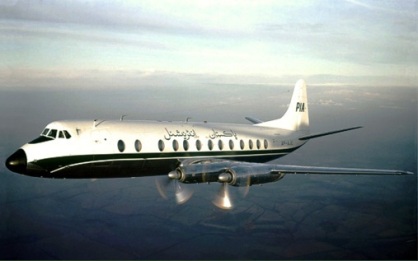
AP-AJC
14 August; Vickers Viscount; AP-AJE
The aircraft took off from Karachi at 1430 on a training flight. It returned back at 1639, and departed again at 1648. At 1707 the aircraft was cleared to land after an ILS approach but due to misalignment with the runway, a go around was initiated. On the second approach, the aircraft was observed flying low over the runway with engines 3 and 4 wind milling. During the second overshoot, the aircraft yawed almost 90 degree to the right, causing the right wing to strike a blast pen wall. It then crashed in flames.
1960
29 January; Douglas DC-3 Dakota; AP-ABC: on a ferry flight from Dacca to Nagpur; on final approach to Sonegaon Airport, Nagpur, a glider crossed the flight path of the DC-3, and in the ensuing collision the right wing of the DC-3 struck the glider which crashed out of control. The DC-3 landed safely. Probable cause: Air Traffic Control error. Total: 3 on board, no fatality.
1961
22 March; Douglas DC-3 Dakota; AP-AAC: the DC-3 on a proving flight crashed during landing at Paksey airstrip in Pabna, East Pakistan. All five crew members and eight officials of the airline aboard the aircraft remained safe but it was damaged and withdrawn from use. Total: 13 on board / no fatalities.
1964
25 June; Fokker F-27-200 Friendship; AP-ALO: the aircraft from Chittagong was approaching Dacca with an active thunderstorm at the airport. While landing it encountered severe gusts and limited visibility, stalled and crashed heavily on the surface, causing both wings to break off. Cockpit crew: Captain Saleem-ul-Haq; First Officer Safdar Nana. Total: 26 on board / 0 fatalities.
1965
26 March; Douglas DC-3 Dakota; AP-AAH: crashed near Lowari Pass, elevation 9, 000 feet near Dir on sector Peshawar to Chitral. Crew: 4 on board/ 4 fatalities. Total: 26 on board / 22 fatalities
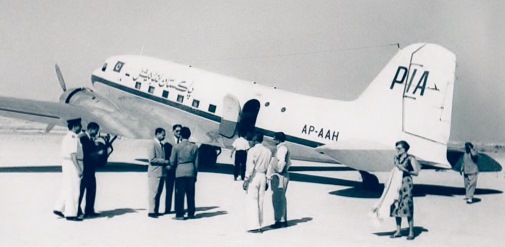
AP-AAH
19 May; B720-047B; AP-AMH: the aircraft departed from Karachi at 1800 on May 19 for Dhahran, and from there to Cairo at 2122. Approaching Cairo at 2340, the aircraft was cleared for a left-hand circuit to Runway 34. The crew reported turning final at 2345 but the aircraft kept descending and struck the ground well short of the runway at 2348. Captain A. A. Khan
The probable cause: the aircraft was carrying out a night visual approach via a circuit flown to the runway. It collided with the terrain while turning final and during alignment with the runway. It can be observed that the captain had never flown an approach to Cairo in a B 720 aircraft. He had sat in the cockpit of a foreign carrier to meet the requirement of experience to this city on another trip. The approach was over an unlit area, the source of optical illusion. I believe the captain lost speed in the turn, and stalled the aircraft while steepening the bank in order to align with the runway on final approach. This is a common mistake and can happen at any level of experience. 125 on board / 119 fatalities.
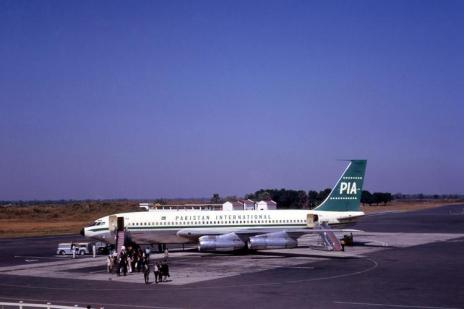
AP-AMH
8/10/1965; Fokker F-27-200; AP-ATT: the aircraft with four crew members departed Rawalpindi for Skardu. After it failed to reach the destination, a search was ordered. The wreckage was located by Pakistan Air Force aircraft and was on a snow covered peak at a height of 13,000 feet near Naran in the Kaghan Valley. 4 on board / 4 fatalities
2/2/1966 Sikorsky S-61N; AP-AOC
10/12/1966; Sikorsky S-61N; AP-AOA
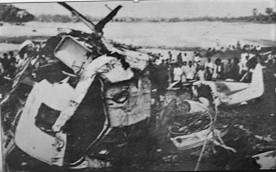
Wreck of AP-AOA
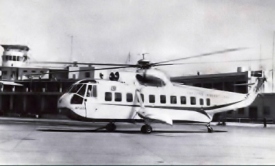
AP=AOA
Delivered to PIA in October 1963, it was one of three amphibious S-61N helicopters flown by the airline for scheduled short-haul flights in East Pakistan’s delta region. During a training flight on 10 December 1966, it crashed near the city of Dacca, killing one of the two pilots. The other pilot in injured condition was removed from burning wreckage by locals. Crew: 2 on board / 1 fatality
26/6/1967; B720-040B, AP-ATQ
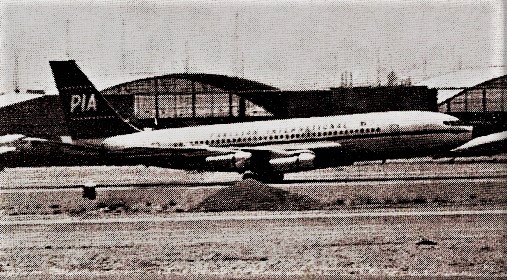
AP-ATQ after landing minus nose wheel at Mehrabad Airport Iran
On June 24, 1967, AP-ATQ, with 134 passengers on board with Capt.Hamid Hussain was operating sector Karachi-Tehran. During approach for landing at Mehrabad Airport, the nose wheel did not deploy down on selection. The Flight Engineer was asked to make a visual check of the nose gear from the lower 41 electronics bay, and reported the nose gear was up while the doors were open. The crew tried different methods to overcome the problem but were unsuccessful. The aircraft circled the airport for an hour and forty minutes to burn fuel. No impact of the landing was felt in the cabin; only a hissing sound resulting from friction of nose section against the runway. The damage to the aircraft was small and was confined mainly to the nose gear doors, the radio antenna. A minor fire developed on the nose gear doors due to friction with the runway, but it was promptly extinguished by the airport fire fighters. AP-ATQ was repaired and returned to service.
6/8/1970; Fokker F-27-200; AP-ALM : the aircraft took off at 2114 from Rawalpindi for a 44-minute flight to Lahore. Last contact with the aircraft was at 2120. It crashed into the ground, left wing low at a high speed. Weather was thunderstorm, heavy rain and gusty winds. The wreckage was found near Rawat about 14.5 miles south-east of Rawalpindi. The weather briefing received on departure was: heavy rain, gusty winds and a thunderstorm cell on the south-eastern side towards the route to Lahore.
Probable cause: disintegrated in thunderstorm while trying to turn back. There were 30 on board, and there were no survivors. Cockpit crew was: Capt Anwarullah; First Officer Farid Nawaz; First Officer Javaid Talat Qureshi.
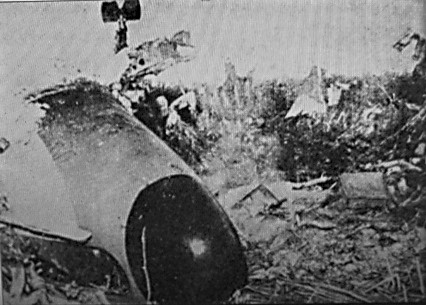
Wreckage of AP-AUV
30/12/1970; Fokker F-27-200; AP-AUV: the aircraft while landing at Shamshernagar Airport, Sylhet, swerved to the right and its right wing and propeller struck the ground. It flipped over and caught fire; ground fine pitch was selected on approach because the aircraft was high. There were 6 fatalities among passengers. Cockpit crew was: Captain Abu Salem; First Officer Saleem Lodhia; First Officer M. Nazir
4/12/1971; de Havilland Canada DHC-6 Twin Otter 300; AP-AWH
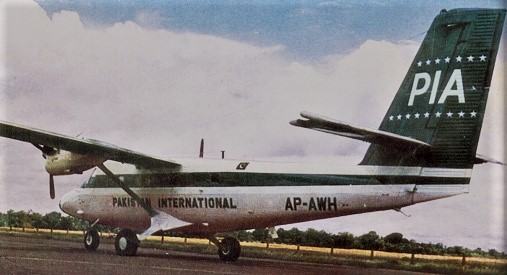
Destroyed on ground by enemy action at Dacca Airport
AP-AWH at Dacca International Air Port in East Pakistan. Six new Twin Otters were delivered to PIA between November 1970 and March 1971. This sturdy little aircraft was suitable for STOL (Short Take-Off and Landing) operations in East Pakistan.
12/12/1971; Fokker F-27-200; AP-ALX: aircraft while assisting Pakistan Navy in December 1971 crashed on the Makran coast near the Iranian border. Cockpit crew: Capt Mubashir Ahmed; First Officer Khalid Javed. Total on board four.
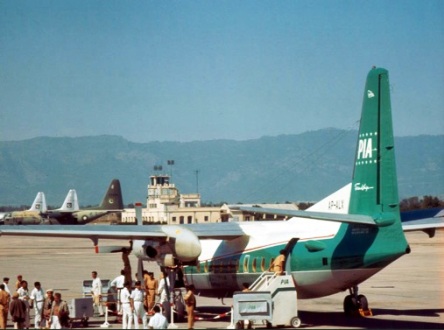
AP-ALX at Rawalpindi
8/1/1972;B720-B; AP-AMJ
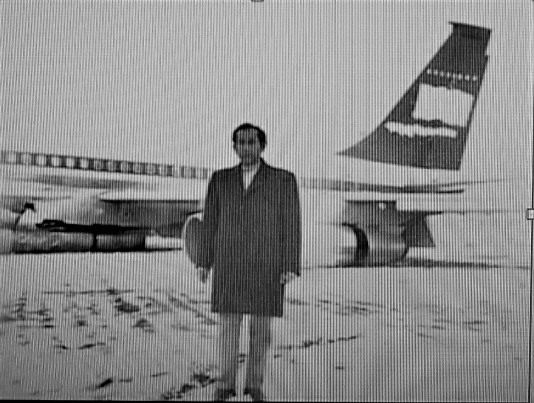
AP-AMJ at Ankara
Ankara; poor communication in cockpit: Capt. M. M. Salehjee and Capt. Mohammed Arshad Mir (co-pilot) were at the controls of this aircraft for a landing at Ankara, Turkey. The co-pilot was the pilot flying the aircraft but due to inclement weather, he asked the captain to take over. Somehow the captain didn’t hear the request, while the co-pilot thought otherwise. So the approach was flown with nobody at the controls until the impact! The aircraft was coming from Tehran with 34 passengers and 10 crew members. The official reason for the accident given was that a visual approach was conducted in marginal weather conditions which required an instrument approach.
After the hard touchdown, the aircraft veered off the runway which they were unable to control. The main under carriage collapsed as it struck the runway. Soon after the crash, PIA logo and titles were painted out from its tail and fuselage because President Zulfiqar Ali Bhutto was due to arrive at the same airport on a VVIP flight. Later the aircraft was repaired and returned to active service. 34 on board / no fatality.
8/12/1972; Fokker F-27-600; AP-AUS: the aircraft departed Gilgit at 0640 for Rawalpindi. It crashed into a snow covered mountain 9,000 feet high above the village Maidan about 8 miles south of Jalkot in the Indus Valley. There were 31 on board, all died. Cockpit crew was: Captain Javaidullah; First Officer Javed Inayat.
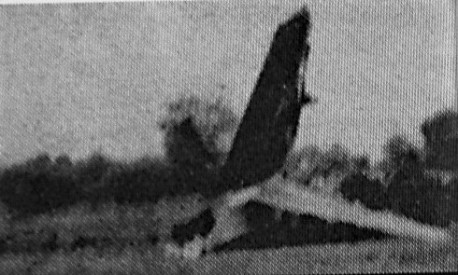
AP-AUW
23/12/1972; Fokker F-27-200; AP-AUW: aircraft undershot runway at Lyallpur (Faisalabad) and crashed after striking trees ½ mile short of runway. Captain was not sitting at the controls. There were 6 fatalities among the passengers. Cockpit crew: Capt. Sajid Qureshi; First Officer Ansar Siddiqui; First Officer M.R. Mirza.
5/7/1975; Boeing 707-373C; AP-AWV: a device exploded in cabin of the aircraft while it was parked on a servicing bay at night at Islamabad Airport. The explosion did not cause in any serious damage to the aircraft structure.
Fokker F-27, Peshawar February 1976
In the first accident, while landing, the engine auto feathered, and the pilot could not control the direction, as the aircraft left the runway on one engine. The repair by Fokker of Holland took three months, and was done adjacent to the runway in Peshawar. Captain R. N. Luther, First Officer Mian Naveed
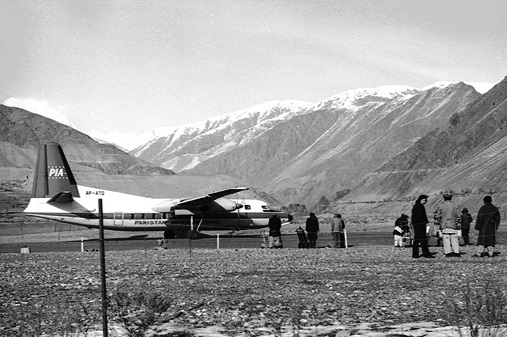
AP-ATO at Chitral
16/3/1977; Fokker F-27-200; AP-ATO: the aircraft took off from Karachi Airport at 0235 for a test flight. Both engines lost power following a power increase during a stall recovery. The aircraft crashed near Central Ordnance Depot (COD) area, Karachi, around 0310. It was engaged in a series of stall tests. 2 on board, the copilot died. Captain Feroze Zafar Khan. Probable cause: overheating of both engines, resulting in their simultaneous failure. This was caused by malfunction of the contact switches of no.1 engine propeller automatic safety pitch locks withdrawal system and pilot’s failure to withdraw the locks manually by placing the HP fuel cock levers into the ‘lockout’ position.
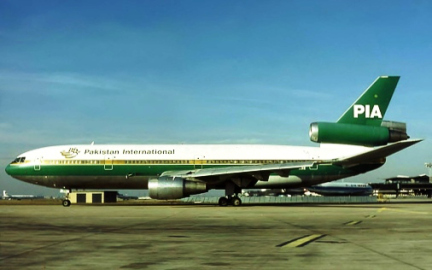
AP-AXE
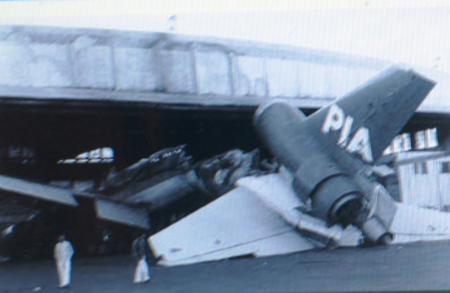
AP-AXE Karachi; aircraft gutted in fire, sabotage?
2/2/1981; DC 10-30; AP-AXE : Karachi; aircraft gutted in fire, sabotage?
5/6/1981; Fokker F-27-600; AP-AXF: on a training flight, the aircraft overran runway after aborting take-off at 90 knots (V1=96 knots) during a touch-and-go at Gilgit. There were 3 on board, no fatalities.
15/9/1985; Twin Otter DHC-6; AP-BCH: on September 15, 1985, a pair of de-Havilland Canada DHC-6 Twin Otter 300 aircraft (AP-BCG and AP-BCH) parked at Islamabad International Airport collided with each other in strong winds. AP-BCH suffered serious damage in this incident.
4/2/1986; Boeing 747-282B; AP-AYW: Flight Engineer was given a form to fill on the performance of the auto-land system on this aircraft. During the ILS approach at Islamabad with the three autopilots engaged for auto-land, the first and then the second autopilot tripped off and the associated warning light and audio came on. First Officer Ahsan Bilgrami, probably on his first flight on the 747 as copilot, tried to silence the audio by pressing the light cover but due to a slight delay in its operation, he actually reactivated the warning each time he pressed.
The audio and warning light could not be silenced, so the Flight Engineer, who at this time was looking for the appropriate circuit breaker to pull, due to the captain’s insistence to shut off the noise and silence this warning, pulled the master warning circuit breaker to comply.
The landing checklist was not completed, probably never started. Landing gear was up. Full flaps were selected for landing, but no warning came on for the undercarriage nor GPWS since the master warning circuit breaker had been pulled earlier. The aircraft landed with the undercarriage up on its belly at Islamabad Airport. At the last minute, during the flare for landing, the First Officer lowered the undercarriage but only the nose wheel partially came out and absorbed some shock. The Boeing Company faulted the airline, PIA, for the faulty and mistimed paper procedure of filling out a form on final approach.
Passengers and crew were evacuated through emergency escape slides. Some of the passengers received minor injuries during the evacuation process. Two engines of the aircraft were damaged beyond repair due to the accident. Total: 264 on board/ no fatalities. Cockpit crew was: Capt. Siraj Ali; First Officer Ahsan Bilgrami (eventually missing in F-27 AP-BBF out of Gilgit); Flight Engineer Arif Rabbani
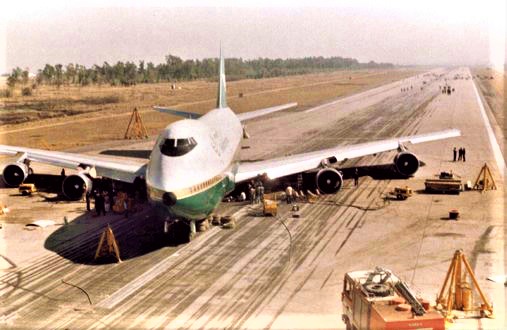
AP-AYW
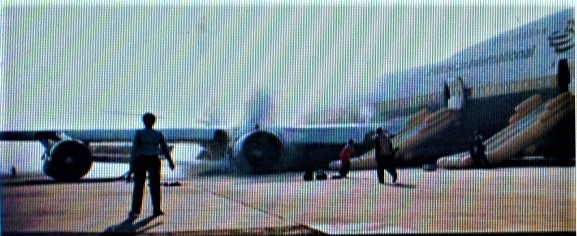
AP-AYW
AP-AYW minutes after making belly landing at Islamabad International Airport on February 4, 1986. Two PIA air-hostesses, one seen near the first emergency escape slide (wearing purple color uniform shirt) and the other one near the second emergency escape slide (wearing magenta color uniform shirt), are moving away from the stricken aircraft. You can see fire fighters giving attention to right inner engine
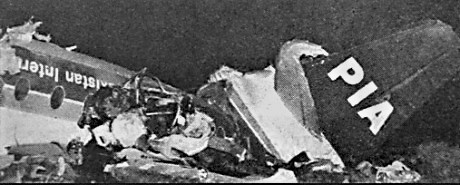
AP-AUX
3/10/1986; Fokker F-27-600; AP-AUX: aircraft undershot Peshawar runway 35 during a night landing, impacted the edge of a ditch, broke up and eventually came to rest inverted. The captain while monitoring the copilot under check, failed to notice that the aircraft had descended below the MDA (minimum descent altitude) of 1580 feet. Elevation of Peshawar is 1180 feet. Captain Reza Zaidi. There were 5 crew on board, 4 fatalities; 49 passengers on board , 9 fatalities.
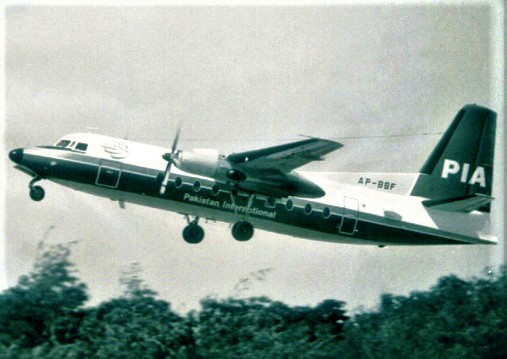
AP-BBF Still missing in Northern Areas.
25/8/1989; Fokker F-27-200; AP-BBF
On August 25, 1989, AP-BBF was operating early morning flight from Gilgit to Islamabad when it vanished in the Karakoram Mountains. The wreckage was not found. There were a total of 54 people on board including 5 crew members.
Cockpit Crew: Captain S.S. Zubair; Captain Ahsan Bilgrami under supervision
18/3/1991; Airbus A300 B4-203; AP-BAZ
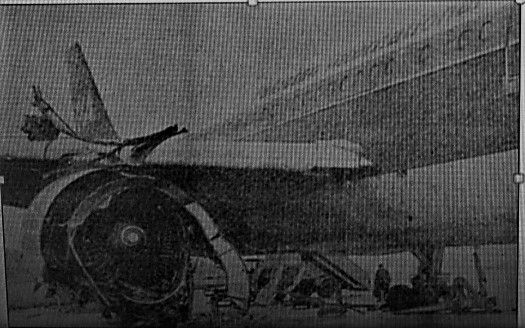
AP-BAZ
The aircraft overran the runway into the overrun area after landing in rain at Islamabad. Engine number two, right wing and landing gear were damaged. Total: 256 on board, no fatalities
A300-B4
Another accident with an Airbus A300 in the early nineties, involved an abort after V1 at Karachi, after the tires were shredded as a result of heavy braking. This happened due to overrun on debris of the engine cowling left by the preceding company flight. The vibration was so intense that in the words of the captain, he was unable to read his flight instruments.
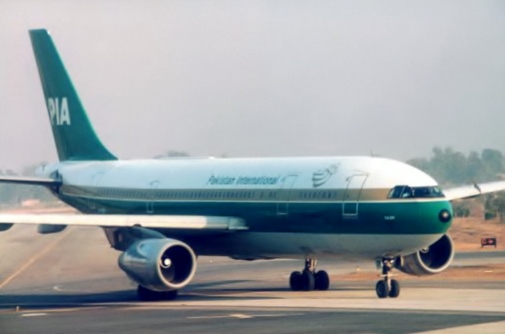
AP-BCP
28/9/1992; Airbus A300 B4-203; AP-BCP: the aircraft departed Karachi at 0613 for Kathmandu. It was cleared for the sierra instrument approach to runway 02 at Kathmandu. The crew was to maintain 11500 feet ASL, and report at 16 DME (16 miles from the VOR/DME beacon, which is located 0.8 mile short of the runway). The Kathmandu airport is located in an oval-shaped valley surrounded by mountains as high as 9,665 ft. Runway elevation is 4313 feet ASL. The descent procedure called for crossing mileage reporting points at specified altitudes; 13 DME at 10500 feet, followed by 10 DME at 9500 feet and 8 DME at 8200 feet. The aircraft after reporting 10 DME, descended to 8200 feet before the 8 DME fix colliding with terrain. The Airbus crashed into a steep cloud-covered hillside at approximately 7300 feet ASL, at 9.16 DME. The sharp gashes in the leading edges of fin and starboard stabilizer attest to the violence of the disintegrating aircraft’s passage through the dense canopy of the hillside jungle. There were a total of 167 on board, none survived. Captain had earlier expressed apprehension of flying to this airport and had broken some runway lights while trying to stop the aircraft on an earlier trip on another aircraft type, the 707. Captain Iftekhar Janjua; First Officer Hasan Akhtar, Flight Engineer Ashraf.
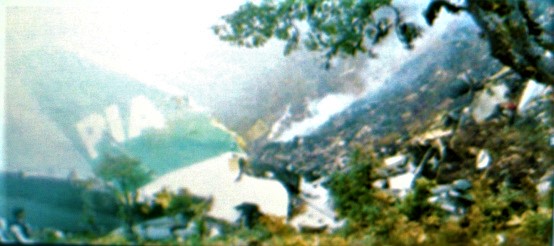
AP-BCP, after crashing into ‘Fan Marker Hill’ 9nm south of Kathmandu Airport, Nepal, on September 28, 1992
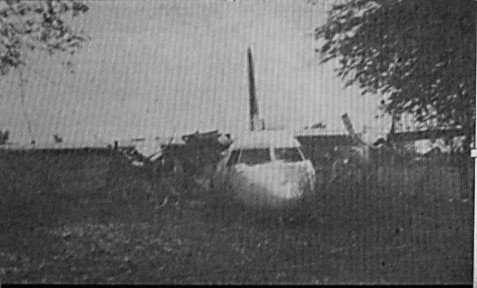
AP-ALN after making crash landing in Dera Ismail Khan on July 5, 1994
5/7/1994; Fokker F-27-200; AP-ALN: The crew had a problem with number 1 engine on final approach at Dera Ismail Khan. The approach was continued, but misalignment with the runway necessitated a go-around. The number 2 engine was selected to full power and gear and flaps were retracted, but the aircraft continued to lose height. A turn was made to avoid the river and the aircraft touched down in a paddy field. It slid for ¼ mile before colliding with a tree. 42 on board, no fatality
0/1997; 21/1B737-340C; AP-BCE at Karachi: the aircraft overran the runway at night while landing in rain. It stopped on the unpaved surface about 650 feet from the runway end. Left side of engine number 1 and left main landing gear of the aircraft suffered extensive damage. The aircraft had earlier operated Karachi to Faisalabad with number 1 thrust reverser deactivated as per Minimum Equipment List (MEL). On the return sector FSL-KHI the runway was wet due to rain and braking action was reported medium to poor by previous landing aircraft. Flap extension was limited to 25 degrees.
18/1/1999; Boeing 737-340; AP-BCE: While landing at Lahore, the right wing dropped resulting in the engine and wingtip striking the runway. The aircraft went off the runway till control was regained, and the aircraft steered back onto the runway. No fatality.
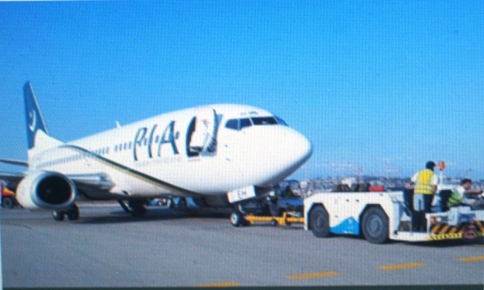
AP-BCE
26/3/2000; Boeing 747-217B; AP-BCO: on landing after a ferry flight to Jeddah, the aircraft’s engine number 4 caught fire. The crew managed to extinguish the flames with the fire extinguisher bottle, but the airport fire fighters had to put out the fire after it re-ignited. All 16 crew members were evacuated without injury. The aircraft sustained damage to the engine, cowling, pylon and adjacent wing fairing. Probable Cause: Fractured fuel supply tube in pylon. Total: 16 on board/ no fatalities
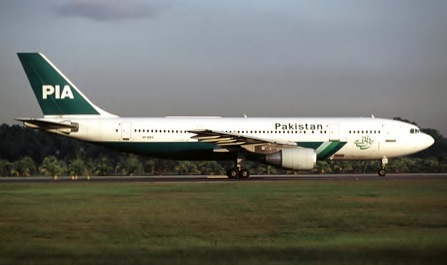
AP-BBV
25/5/2001; A300 B4-203; AP-BBV : the aircraft took off from Lahore Airport at 1200 for Karachi. About half an hour later and approximately 100 miles from Lahore, there was an explosive decompression caused by the rupture of the aft pressure bulkhead at 28,000 ft. altitude. The broken components jammed the elevator control, ruptured the hydraulic lines and the fuel lines. The Airbus went into a climb and then went into a dive. The crew was able to recover the aircraft from the dive at 8,000 feet. It returned to Lahore and made an emergency landing. There were no serious injuries to the passengers or crew. The investigation indicated that the pressure bulkhead failure was due to corrosion caused by its proximity to a lavatory. There were 265 on board, no fatality.
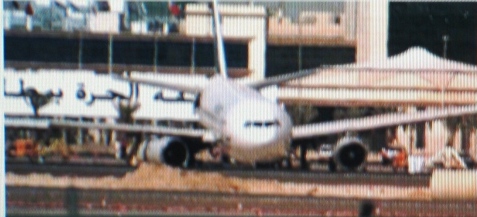
Airbus 300; AP-BCJ Dubai; right main gear strut failure; aircraft write off
17/10/2001; Airbus 300; AP-BCJ: The aircraft veered off the side of the runway at Dubai after the right-hand main landing gear collapsed on touched down. It skidded and eventually came to rest in sand 165 feet away from the runway. It sustained damage to its right wing structure and the number 2 engine, which partly broke off from the wing. All 193 passengers and 11 crew were evacuated safely.
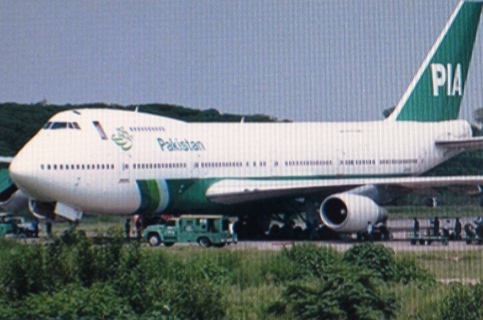
AP-BAK Takeoff abort
20/7/2003; Boeing 747-240B; AP-BAK: the aircraft aborted takeoff at Islamabad after experiencing problem with engine number 2. It came to rest near the end of Runway 30 with all its sixteen main landing gear tyres (tires) deflated. There were 264 on board, no fatality.

AP-BBA seen after accident at Jeddah on March 1, 2004
1/3/2004; Airbus A300B4-203; AP-BBA: the takeoff at Jeddah (King Abdul Aziz International Airport) was aborted at high speed after the left main gear tyres blew. Undercarriage suffered serious damage, flying metal pieces from fragmented wheel assemblies of nose gear struck fan blades of both engines and caused serious damage to them. Aircraft declared constructive total loss and withdrawn from use. According to investigations conducted by Saudi authorities, defective tyres were the cause of this accident 273 on board, no fatalities. Sector: Jeddah – Quetta
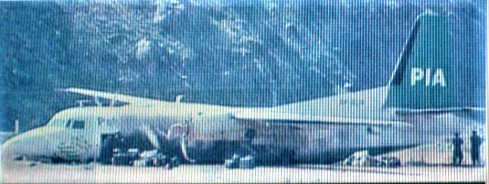
Security personnel stand guard near PIA Fokker F27 (registration AP-AUR) sitting outside the runway of Chitral Airport on June 16, 2004
10/6/2004; Fokker F-27-200; AP-AUR: the aircraft could not stop on the runway, and overshot the area of the airport. It slipped into nearby fields and all tyres burst. The accident caused damage to the aircraft’s landing gear, engines and nose section. The aircraft was declared a write-off and withdrawn from service after the accident.
Probable cause: The aircraft landed too far up the runway leaving little space for itself to slow down. Total: 40 on board/no fatality; Sector: Peshawar-Chitral
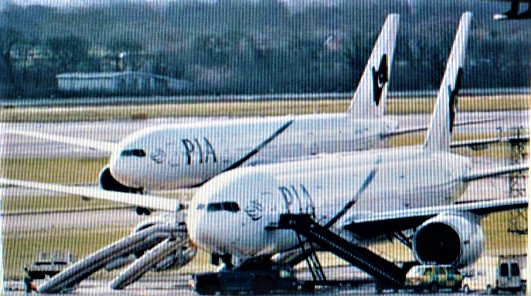
AP-BGL
1/3/2005; Boeing 777-240ER; AP-BGL: After landing the aircraft was taxiing at Manchester, when flames were seen around the wheels of the left main landing gear. The airport Rescue and Fire Fighting Service (RFFS) attempted to extinguish the flames, copious quantities of what the RFFS Watch Commander assessed as smoke was produced and, fearing that the fire was getting out of control, he advised the aircraft captain to evacuate the aircraft. Minor injuries were sustained by some passengers and several fire service personnel during the evacuation. The aircraft suffered slight damage to fuselage skin adjacent to door 3R, heat damage to the No. 10 tyre (tire) and hydraulic hoses on the left main landing gear. The Boeing 777 returned to service after repairs.
Probable cause: The investigation determined that the cause of the fire in the No. 10 main landing gear wheel, most likely resulted from the maintenance practice used when cleaning the wheel heat shields. It was likely that these had been immersed in a flammable solvent, which allowed the ceramic fibre insulation material contained within to become contaminated. The fire occurred on the second landing after the wheel had been fitted to the aircraft, when the brake pack temperature was likely to have been higher than on the previous landing. Total: 344 on board, no fatality
Fokker F27-200 Friendship; AP-BAO; 13/7/2005: AP-BAO while landing at Lahore went off the runway. Left engine propeller did not go into ground fire position (below 18 degrees lock position).Fokker. No fatality.
Probable cause: A detailed inspection of left hand engine revealed that the throttle control rod was found disconnected at the engine control box. Control lever bolt and nut were found inside the bottom of engine cowl. Split pin was not retrieved. The engine was installed eight days prior to the incident. Further investigation revealed that the split pin was not installed
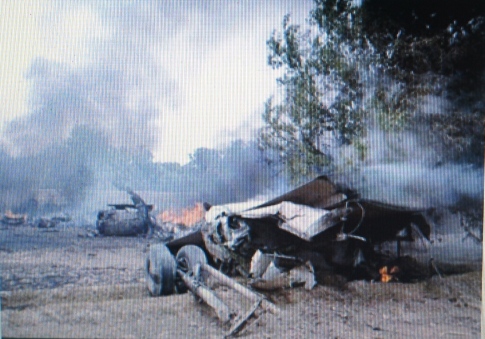
10/7/2006; Fokker F-27; AP-BAL: Aircraft had engine failure before V1 at Multan but takeoff was continued. During the take-off roll, engine number 2 exceeded the turbine gas temperature (TGT) limit and caught fire. The pilots failed to retract undercarriage after getting airborne. The aircraft struck high voltage electricity wires, and after hitting some trees and an orchard boundary wall, it crashed into empty field around 0706, within 50 seconds of the take-off from Multan.
It was loaded with 4700 lbs of fuel and disintegrated on impact with ground . It caught fire killing everyone inside . Air Hostess Amira Sikandar was found alive at the crash site and was pulled out from the burning wreckage. She was rushed to the Nishtar Hospital in Multan but breathed her last in the ambulance on way.A young girl on the ground also became unfortunate victim of this accident. The crash site is around three miles from Multan Airport..
During the preliminary investigation parts of the right engine were found on the right side of the runway indicating engine number 2 failure during take-off. However, there was no evidence that the engine failure was related to the engine design. Furthermore, no evidence was found that the aircraft or its systems had any bearing on the cause of the accident. Poor maintenance work was blamed for the failure of engine 2.
Probable cause: the crew did not apply proper flight technique for an engine failure. They did not retract landing gear after getting airborne, and also did not adequately correct the rolling tendency, which caused additional loss in climb performance. The Flight Data Recorder (FDR) recording showed that the crew was able to recover the heading and rolling deviations occasionally. Therefore it can be concluded that the aircraft was controllable on one engine Total: 45 on board/ 45 fatalities. 1 fatality on ground.
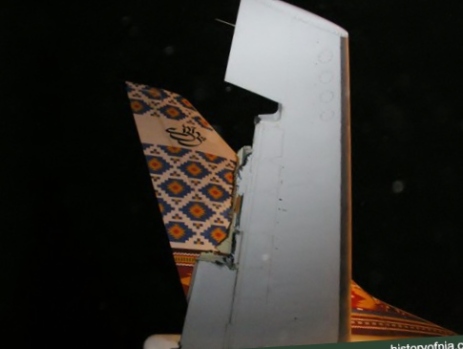
AP-BCC
3/9/2006; B737-340, AP-BCC: Pk 257 was operating from Islamabad to Doha on September 3, 2006 when part of its elevator separated from the fuselage in flight. During descent into Doha, the starboard side elevator broke off from the aircraft with a loud noise and the aircraft suffered severe vibration. The crew declared an emergency and continued the approach to Doha Airport. On lowering the landing gear there was no indication in the cockpit about its status. A fly pass at 1000 feet was flown over the airport to get a verification from the control tower about the status of the landing gear; a visual check of landing gear from the cabin was also made. The aircraft on the second approach made a safe landing. Cockpit crew was Capt. Shayan Haqqi and First Officer Faisal Janjua
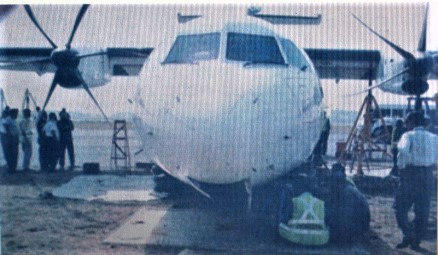
AP-BHO
30/5/2009; ATR 42-500; AP-BHO: was operating PK-688 from Multan to Lahore. During landing at Lahore the aircraft skidded off the runway and came to rest on unpaved surface. All 43 passengers and 4 crew members aboard the aircraft remained safe. The landing gear, nose section, landing gear doors and fuselage skin near landing gear sustained damaged in this accident.The aircraft was put out of service for arrival of spare parts till October 2009.
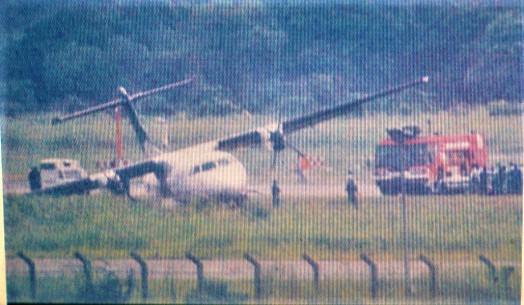
AP-BHJ damaged during landing at Lahore Airport on August 31, 2012
31/8/2012; ATR 42-500; AP-BHJ: was operating PK-653 from Islamabad to Lahore and overshot the runway, touching down in the overrun. It struck the aircraft arresting barrier on the runway and came to rest on grass on the right side of Runway 36R. All 42 passengers and 4 crew members aboard the aircraft remained safe. The aircraft’s right main landing gear and engine suffered substantial damage in this accident. Weather was wet and rainy at the time of landing. Aircraft was damaged beyond repair and withdrawn from use.
18/11/2012; Airbus A310-308; AP-BEB: AP-BEB while operating as PK-787 from Karachi to London it experienced a technical problem with number 1 engine which emitted loud bangs; streaks of flames were seen about three minutes after takeoff from Karachi. The aircraft landed safely at Karachi Airport at 0708 and was grounded. Total: 183 on board, no fatality

AP-BEB
AP-BEB after landing at Jinnah International Air Port Karachi on November 18, 2013
11/2/2013; Boeing 737-33A; AP-BEH: was operating as PK-259 from Islamabad to Muscat via Sialkot when its left main landing gear collapsed while landing at Muscat Airport. The aircraft suffered damage to its left side main landing gear, engine number 1 and wing. All passengers and crew members aboard the aircraft remained safe in this incident. Aircraft was damaged beyond repair. Total: 114 on board, no fatality
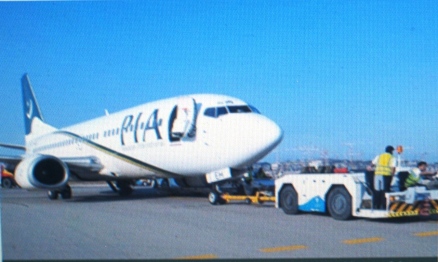
AP-BEH at Muscat International Airport on February 11, 2013
6/10/2013; Airbus A310-308; AP-BEC: engine number two of AP-BEC caught fire after takeoff from Jinnah International Air Port (JIAP), Karachi. The aircraft returned safely back and was later grounded. Total: 62 on board, no fatality
8/1/2014; Airbus A 310-308; AP-BDZ: AP-BDZ fuselage was damaged during terrorist attack at Jinnah International Air Port (JIAP) Karachi. The aircraft was parked in maintenance area at the time of the attack. Fuselage received bullet hits and holes due to shrapnel. The aircraft was grounded and did not return to service.
8/1/2014; Boeing 747-367, AP-BFV: AP-BFV fuselage was damaged during terrorist attack at Jinnah International Air Port (JIAP) Karachi. The aircraft was parked in maintenance area at the time of attack. Fuselage received bullet hits and holes due to shrapnel or RPG. The Boeing 747 did not return to service.
24/6/2014; Airbus A 310-324 ET; AP-BGN: the aircraft received bullet hits during landing at Peshawar Airport. A female passenger received a fatal injury, while two male flight attendants received non-fatal injuries. The aircraft landed safely at Peshawar Airport. Crew: 0 fatalities /12 on board. Passengers: 178 on board, 1 fatality. Total 190 on board, 1 fatality. Sector Riyadh-Peshawar
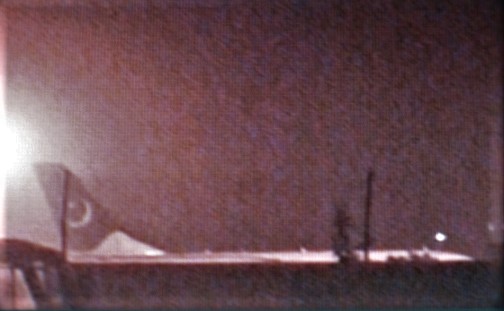
Airbus A310-324 (AP-BGN) after landing at Bacha Khan International Air Port (BKIAP) Peshawar on June 24, 2014
| Date: August 8, 2016 |
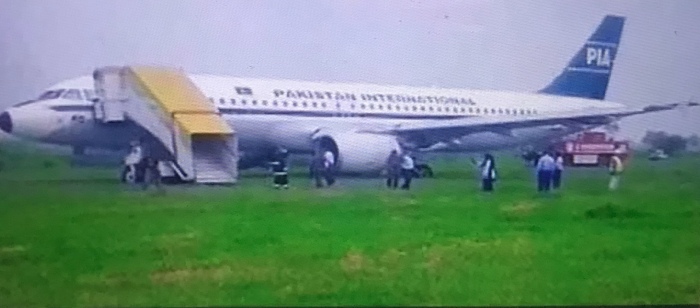
Type: Airbus A320-214 (AP-BLA)
Flight PK-451 was scheduled to depart from Islamabad at 0800 hours for Skardu but eventually departed at 1249. During the flight, the cockpit crew observed some problem with aircraft’s hydraulic system and returned to Islamabad. The A320 landed at 1333 but veered off the runway during the landing roll and came to rest on grassy surface. Aircraft’s engines suffered foreign object damage (FOD). All passengers and crew members remained safe and were evacuated through mobile stairs. The aircraft was grounded for repairs.
Date: December 7, 2016
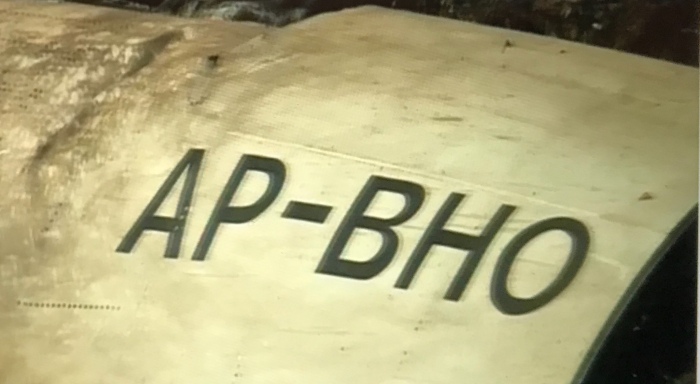
Type: ATR 42-500 (AP-BHO)
PK-661 departed from Chitral at 1538 for Islamabad. At 1609, the flight was handed over from Cherat to Islamabad air traffic control and appeared on Islamabad radar at 1612. At 1614, the aircraft reported failure of an engine and gave a Mayday call. The aircraft began descending at 1615 and another Mayday was issued.
Nothing further was heard from the aircraft after the cockpit crew replied “standby” at 1620. The aircraft crashed into a hill near village Saddah Batolni, near Havelian, Abbotabad, and caught fire
Date: January 3, 2017
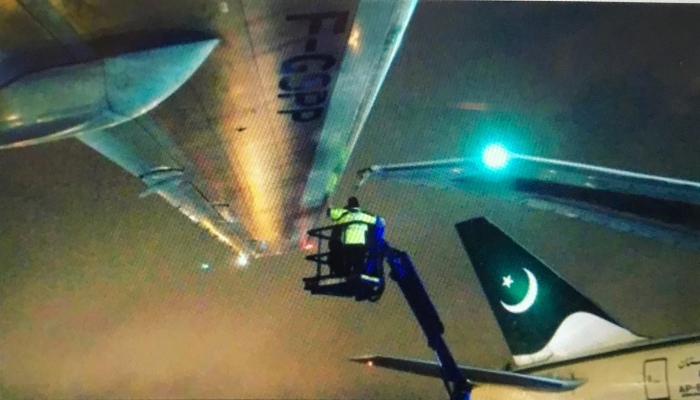
Starboard side wing tip of AP-BGY touched port side wing tip Air France Boeing 777-228ER registration F-GSPP parked at Toronto Pearson International Airport. The incident happened when AP-BGY was taxiing towards jet bridge after arriving as flight PK-789 from Karachi via Lahore. The Air France Boeing 777 had arrived at the airport at 4:45 PM as flight AF-356 from Paris Charles de Gaulle Airport. Both Boeing 777s were grounded for inspections and repairs. On January 6, AP-BGY departed from Toronto as flight PK-790 to Lahore.
Date: July 11, 2017
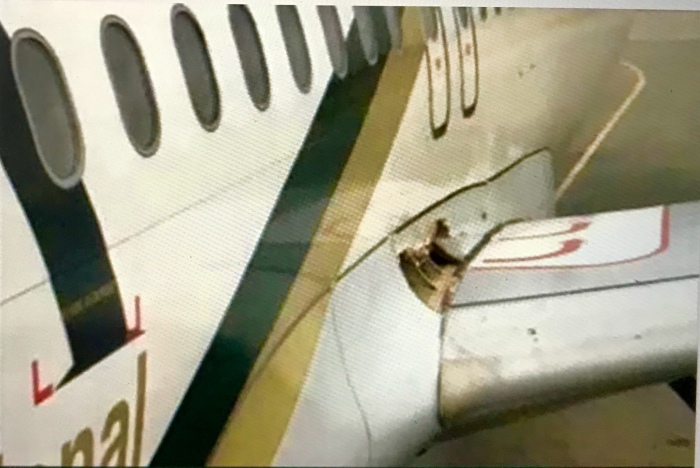
Remarks: Port side wing root fairing panel was damaged by bird hit when flight was approaching Bacha Khan International Air Port (BKIAP), Peshawar, for landing. The A320 landed safely at the airport and returned to service on the same day after getting damaged fairing panel replaced.
Date: September 5, 2017
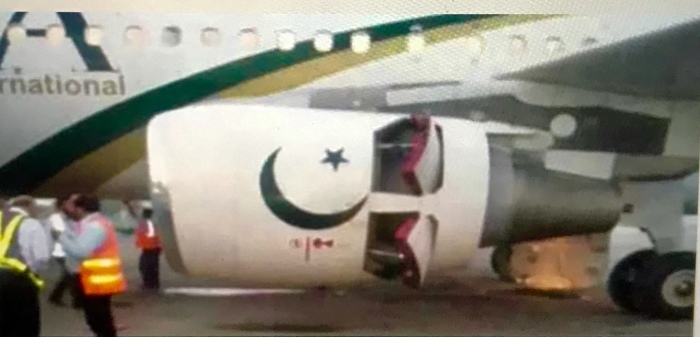
Type: Airbus A320-214 (AP-BLD)
Pk 296 during approach to Lahore Airport experienced hydraulic problem. The aircraft landed at Lahore at 0454 and remained stranded on runway for about eleven minutes with opened landing gear doors and engine thrust reversers unstowed. It was towed from runway to parking bay.
Date: October 11, 2017

Type: Airbus A320-214 (AP-BLU)
Total: 0 fatalities/140 on board
The aircraft departed Sialkot at 0618 as flight Pk 755 to Riyadh. During the flight, a cargo compartment smoke indication was received in the cockpit. The cockpit crew used cargo compartment fire suppression system and diverted to Lahore where the aircraft landed at 0642. The aircraft then taxied to a parking bay where passengers disembarked through mobile stairs. No evidence of a fire was detected.
Date: June 5, 2018
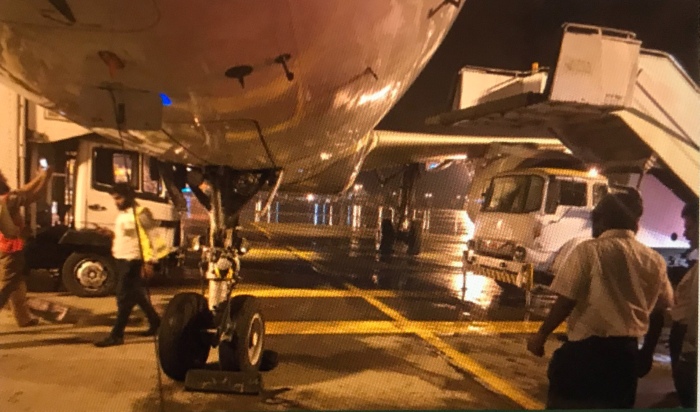
Pk 244 from Dammam to Sialkot diverted to Lahore Airport due to bad weather near Sialkot. The aircraft landed in Lahore at 1803. A storm struck Lahore Airport when the aircraft was served by mobile stairs on left side and an ambulift on right side. The storm pushed the aircraft sideways to the right. Due to the aircraft’s movement, its engine #1 cowling collided with mobile stairs. On the starboard side, the aircraft’s forward baggage/cargo hold door got damaged by ambulift. The aircraft was grounded. After completion of initial repairs, the aircraft was ferried from Lahore to Karachi as on June 6. The A320 returned to service on June 7.
Date: June 5, 2018
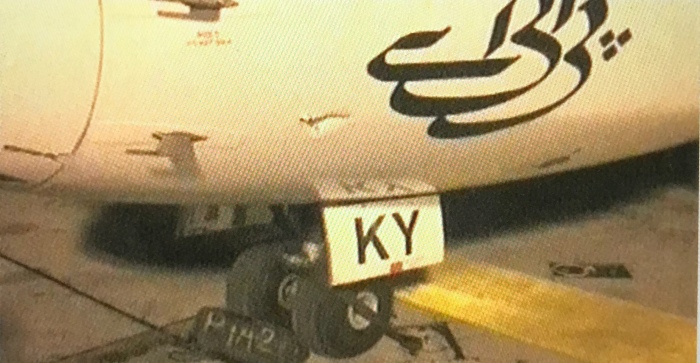
- Type: ATR
The aircraft had arrive at Lahore as Pk 684 from Multan and was to perform flight PK 654 to Islamabad, when a storm struck Lahore Airport. The force of the storm pushed the aircraft’s nose section onto the port side and it hit the ground equipment. The aircraft was grounded for repairs and returned to service on June 7.
Date: November 10, 2018

- Type: ATR 72-500 (AP-BKY)
The aircraft was unable to stop on the runway after landing at Panjgur Airport and overran it. One main landing gear tire got deflated on the rough surface. All passengers and crew remained safe and disembarked the aircraft. The aircraft was moved to a parking bay on November 11.
Date: November 18, 2018
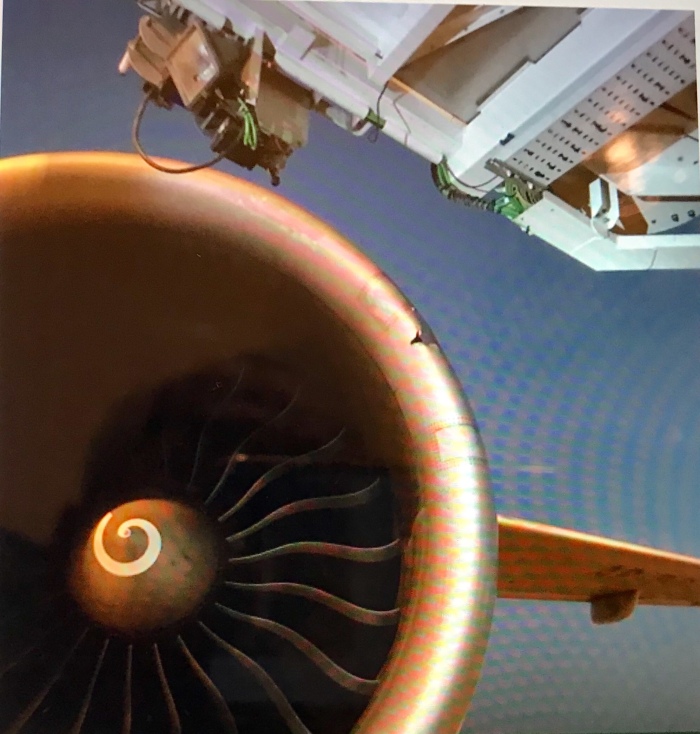
- Type: Boeing 777-240LR (AP-BGZ)
The inlet cowling of engine # 1 was damaged by passenger boarding bridge at Karachi. Due to the incident, the aircraft’s departure for Toronto was delayed by more than 6 hours, eventually departing at 1516. The aircraft’s damaged inlet cowling was replaced.
Date: November 24, 2018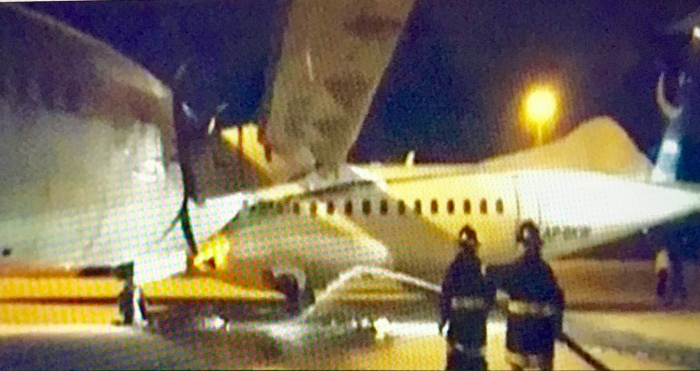
- Type: ATR 72-500 (AP-BKW)
- Location: Jinnah International Airport, Karachi, Pakistan
The aircraft during a test engine run up collided with Shaheen Air Boeing 737-400 (AP-BJU). Engine number one propeller of ATR was damaged in the collision.
Through courtesy of historyofPIA.com



The incident of AP BGY wing tip hitting
The Air France 777 cannot happen
If the PIA pilot had followed the centre
Yellow on the ramp … this also depends
On the positioning of the ramp is it
Straight or in a angle . If the stand was in a angle then there is a danger of wing to wing hit .
However wing tip hit can not happen if the aircraft is towed in or when pushback is in operation .. on pushback a sharp turn is applied by the driver to make sure aircraft is easy to straighten
Up .
2 ramp agents before pushback are allocated to each wing to monitor that there is no wing to wing hit before they
Remove the towbar from aircraft and the steering pin .
It could have been that ramp crew were not on stand when AP BGY approached as I know the aircraft is not a 300ER but a 200LR as I worked on it loading
Freight and baggage .
There was a incident at LHR when a
American B777 wing tip hit the a side
Building were there a tight turn had to applied because of the tight location
Of stand but one our ramp agents was not monitoring the wing and it
Struck the building .
The ramp agent lost his job
Quite a commendable work of historic value. Well done.